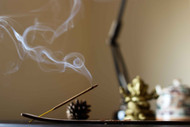Frankincense: History and Culture
Posted by Pure Cosmetica on 4th Apr 2022
Sacred Frankincense is considered by many to be the most highly valued variety of Frankincense on Earth. Read a brief history of Frankincense and its uses through the ages.
Origins
Sacred Frankincense (Boswellia sacra), found only in modern-day Oman, is considered by many to be the most highly valued variety of frankincense on Earth and is believed by experts to be the variety of frankincense that was given as a gift to Mary and Joseph from the 3 wise men at the birth of Christ.
Frankincense has been traded in the Middle East and North Africa for upwards of 5,000 years. It had such a wide range of uses. The ancient Egyptians bought entire boatloads of the resin from the Phoenicians, using them in incense, insect repellent and salves for wounds and sores; Frankincense was also a key ingredient in the embalming process. Cosmetically, Frankincense was charred and ground into a power to make the heavy kohl eyeliner Egyptian women famously wore.
Frankincense in Egypt
The Egyptians loved to use simple fragrances in their daily lives and did so at every opportunity. At festivals and celebrations women wore perfumed cones on their heads which would melt under the heat, releasing their beautiful fragrance. After bathing, they would anoint their bodies with oil to protect them from the drying effects of the baking sun and to rejuvenate their skin.
During the period from 1539 to 657 BC, the Egyptians continued to refine their use of aromatics in incense, medicine, cosmetics, and finally perfumes. Until just a few hundred years before the birth of Christ, the Egyptian perfumery industry was celebrated as the finest in the whole of the Middle East and beyond. So great was their reputation as master perfumers, that when Julius Caesar returned home with Cleopatra after conquering Egypt around 48 BC, perfume bottles were tossed to the crowds to demonstrate his total domination over Egypt.
The beauty of Cleopatra and her enigmatic seduction was legendary as were her honey and milk baths rich in essential oils such as rose, jasmine, neroli and frankincense.
Frankincense in religion
At the time Jesus is thought to have been born, frankincense had a higher value than gold. But despite its significance in the New Testament, this treasured oil fell out of favor in Europe with the rise of Christianity and fall of the Roman Empire, which essentially obliterated the thriving trade routes that had developed over many centuries.
In the early years of Christianity, incense was expressly forbidden because of its associations with pagan worship; but it has since made a complete comeback and is used extensively in cosmetics, and as a celebratory scent by certain denominations in specific religious ceremonies.
Frankincense (Boswelia carterii, fereana, and sacra) is a highly prized essential oil obtained from the resin of a small tree. This tree, the Boswelia, is native to North Africa and the Middle East. It has been used for thousands of years for spiritual purposes.
Frankincense was used in ancient religious ceremonies, because it slows breathing, soothing the body and mind making it extremely useful for meditation and prayer.
Aromatic properties
The scent of Frankincense, an intriguing combination of sweet, musky and earthy all in one, can help to naturally calm you down. It is said that Frankincense may help to improve emotional balance, increase resistance to stress and tension, and may also help to improve one’s attitude. Controversially, Frankincense also may help those with mild depression. How so? Frankincense is known to have anxiolytic properties, which is a fancy way of saying it can help reduce anxiety. We don’t know why, perhaps the richness and complexity of the scent brings us right back to the present moment where we need to be to have any chance of peace and happiness.
Where to find Frankincense
We are all aware these days of the benefit of carving out a space for stillness and reflection in our busy days. As an aid to your meditation practice we recommend you use a few drops of Pure Body Luxe NOURISH Face & Body Oil and allow the scent to permeate your environment and enhance your meditation practice from your body.
 AUD
AUD  US Dollar
US Dollar

